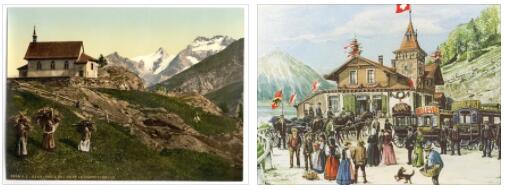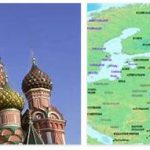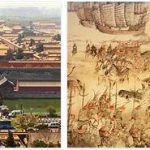The territory between the Rhine, the Alps and the Jura, which currently constitutes Switzerland (which is a more political rather than geographical expression), was initially inhabited by Ligurian tribes, then Celtic, and finally towards the century. I a. C. by people called Helvetii by the Romans. Around 62 a. C. this population, for unclear reasons (the pressure of the Germans coming from E, or the appeal of the Auvergne allies), moved towards W against the Aedui. The Romans, fearing for the safety of the territory they owned (the Province), intervened and Julius Caesar in 58 a. C. drove them back to where they came from and soon submitted them to Rome. The territory did not have an administrative unit, but was divided between Transpadana Italy, Raetia, Upper Germany and Gallia Narbonensis. The Rhine became the northern frontier of the Empire and numerous Roman garrisons garrisoned the country. Access to the new territory was made possible by the construction of two large roads, one which, starting from Clavenna (Chiavenna) via the Maloja and Julier passes, reached Curia (Coira) and, from there, following the course of the Rhine, continued to Vindonissa (Windisch ) and ended in Augusta Rauricorum(Augst); the other that from Aosta passed through the Gran San Bernardo, Lausanna (Lausanne), Aventicum (Avenches) and joined Vindonissa with the previous one.
Soon Christianity, spreading in the wake of the Roman legions, entered the region which, shortly afterwards, had to endure the first assaults of the Germans. These, breaking through the limes placed between the Rhine and the Danube, violently poured towards the S: in 258 d. C. the Alemanni struck the first of the repeated assaults that induced the Emperor Diocletian to build in 294 a defense line that went from Vindonissa to the current Liechtenstein and later Valentinian I to restore the limes. In the sec. IV the Alemanni resumed the attacks and occupied the central plateau, leaving the valleys clear. For this reason, the Raetia preserved its Latin character, while the Burgundians entered the territory from the West, with the consent of the Empire, as foederati to settle permanently between Lake Neuchâtel and Durance, in Haute-Savoie. The Arian heresy entered the region with both of these invasions, but Christianity regained the upper hand in the 10th century. VI and VII by the Franks, who occupied the region, and above all by the Irish missionaries of which San Colombano and San Gallo were the most famous. According to Dentistrymyth, at the time of the partition of the Carolingian Empire with the Treaty of Verdun (843) the current Switzerland (which already in the Merovingian period had undergone divisions of not long duration between the various kings of that dynasty) was assigned to Lothair together with Italy and the territory included to the N between the Alps, the Rhine, the North Sea and the Meuse, and to the S between the Alps, the Saône, the Rhone and the Ligurian Gulf. However, with the Treaty of Meersen (870) almost all the territory of present-day Switzerland passed to the kingdom of Germany while that of Italy remained the territory to the S of the Rhone. This partition, followed by other annexations that took place after the fall of the Carolingians, ended up confusing the history of Switzerland with that of Germany. The feudal lords of the country, lay and ecclesiastics, took part in the investiture struggle; among the noble families emerged in particular the counts of Lenzburg (Ghibellines) and the families of Rheinfelden, of Kiburg and the Zähringen (Guelphs); among the ecclesiastics the abbots of St. Gallen and the bishops of Basel and Lausanne (Ghibellines). Eventually the Zähringen prevailed and founded numerous fortresses and cities: Freiburg, Morat, Yverdon, Bern etc.; Meanwhile, S infiltrated the accounts Savoy. At the extinction of the Zähringen (1218) their domains passed for a short time to other families (Lenzburg and Kiburg) and then, finally, to the Habsburgs. However, when this family inherited the aforementioned territories, feelings of autonomy had already developed in them, following the example of the Lombard municipalities and the free Germanic cities.
It was in this context that Basel in 1264, St. Gallen in 1272, Solothurn in 1280 (and other cities thereafter) obtained the franchises. It was in this atmosphere that the countries of Uri and Schwyz (which respectively in 1231 and 1240 had placed themselves directly under the Empire) together with the country of Unterwalden, faced with the expansion of the Habsburg dominions that surrounded them, in the 1291 swore a perpetual alliance which had as its purpose the defense of their freedoms. These were confirmed by the Emperors Adolfo of Nassau and Henry VII of Luxembourg (at the time fighting with the Habsburgs, respectively in the years 1297 and 1309) as well as from the victory that the three confederate countries (the Waldstätte) in 1315 brought back to Morgarten over Leopold I of Habsburg. This was a decisive event: the three countries, with the Brunnen pact, renewed the oath of 1291 and obtained from Ludovico il Bavaro, in 1316, the recognition of their immediate dependence on the Empire. The Habsburgs, deprived of all rights over the three valleys, recognized the new situation in 1318. However, the three countries continued their hostilities by supporting the revolts that broke out in the nearby cities against the Habsburgs: Lucerne, which rose in 1330, entered the league with the Waldstätte two years later, followed by common minors (Gersau, Weggis and Vitznau), yes that all the countries on the shores of the lake, later known as the Four Cantons, were united by a treaty of alliance. However, the formation of a new state was still a long way off. Zurich (1351), where democracy had supplanted the ruling oligarchy, Zug and Glarus were then added to the initial alliance.(conquered in 1352 and became allies, the first in 1365, the second in 1386). In 1353 Bern also entered the alliance. In a new conflict the Habsburgs were defeated in Sempach in 1386 and in Naefels in 1388. In the sec. XIV, the cities had control over the countryside in the interior of the individual Orte (Cantoni). The expansionist aims of the cantonal alliance, in addition to turning to the S, towards the Gotthard, also turned towards the N, creating divergences of views between the cantons themselves, each of which pursued its own sectoral policy: the victories of the Austrians in 1388, obtained on the princes and cities of Swabia allied with Bern, Zurich, Zug, Solothurn and Lucerne, put an end to a strategic agreement that could have led to the formation of a political body extended to southern Germany as well. The union between the Confederates was reduced but intensified: the Sempach Convention (1393) created the alliance between eight cantons and gave birth to a great military power brought to expand for economic and strategic reasons. But the lack of central power dispersed the forces. The Canton of Uri practiced a policy of pushing towards the S, after having concluded an agreement with Milan in 1335 to be exempt from paying tolls on the Gotthard, occupied the Val Leventina in 1403 and the Val d’Ossola in 1410. Hunted in 1422 from Filippo Maria Visconti, winner of an important battle in Arbedo, the citizens of Uri returned in 1441 to the Val Leventina which was then definitively ceded by the Milanese in 1478. The Canton of Schwyz, in turn, worried about being surrounded by the Habsburg possessions, took advantage of a jacquerie against the abbot of St. Gallen to take possession of Appenzell which thus entered the league in 1411; the united Confederates, with the support of the emperor Sigismund who abolished the feudal regime in their territories, occupied the Aargau (1415) which stood, almost like a wedge, between Bern and Zurich; in 1454 also St. Gallen and in 1460 Thurgau were taken.
On reaching the Rhine, the Confederates overcame it by making an alliance with the cities of Rottweil (1463) and Mulhouse (1465) which later became part of the federation, respectively in 1515 and 1519, but failed before Waldshut (1468) and gave up. to take the Black Forest and Sundgau (southern Alsace). An attempted secession of Zurich in 1439 ended the following year with the defeat of this city, but resulted in the French intervention in favor of Zurich in 1444 and the victory over the Confederates at Saint Jacques. This victory had no consequence, however, because the purpose of the expedition, the conquest of Basel, failed. All this caused a dispersion of forces and an impoverishment of the country for which many Swiss emigrated and became mercenaries in the service of foreign sovereigns. Freiburg and Solothurn, Stans regulated relations between the Confederates until the French Revolution. All this did not prevent the Swiss from frustrating the attempts to conquer Charles the Bold who was defeated at Grandson and Morat in 1476 and Nancy the following year. The political disagreement between the various cantons prevented them from maintaining Franche-Comté and Vaud: the first passed to the house of Austria, the second returned to the Savoy. Later, with the war waged by the cantons and the Grisons leagues against Maximilian I of Habsburg, the Swiss proved to be invincible by beating the Swabian League and the Emperor in a series of battles in 1499. This prevented the Swiss from paying the tax that the emperor demanded from all employees of the Empire, and provided implicit recognition of their independence. Basel and Schaffhausen entered the Confederacy in 1501, but Vorarlberg, which had also been conquered, was lost to the Habsburgs. AS the expansion was simpler and more lasting: in 1503 Bellinzona and Val Blenio, which allowed the control of the San Gottardo, were removed from the Duchy of Milan; in 1512, the French expelled from Lombardy, the territories of Domodossola, Locarno, Cuvio, Luino, Lugano and Mendrisio came under Swiss control. In the same years the Grisons leagues occupied the Valtellina, Val Chiavenna and the County of Bormio. All these territories formed a kind of domain managed jointly by the Confederate cantons. Appenzell in 1513 became the thirteenth canton, Mulhouse in 1515 joined more closely to the Confederates. This was the moment of greatest power of the Swiss: the new Duke of Milan Massimiliano Sforza was actually under their protection. In 1515 Francis I of France defeated the Swiss at Marignano, took possession of the Milanese dukedom and had Domodossola, Cuvio and Luino returned. It was the end of the territorial expansion. From that moment, for almost three centuries, the 13 Cantons, the territories managed by them in common and their allies remained as they were without notable constitutional changes. The introduction of the Protestant Reformation – initiated by Huldreich Zwingli in 1519 in Zurich, it brought ruin and religious wars to the Confederation. First Zurich and then other cities (St. Gallen, Constance, Schaffhausen, Basel, Mulhouse, Strasbourg, Bern) – joined the Reformation. This found ready followers among the city bourgeoisie who took the opportunity to break down what remained of the feudal ties: the cities were connected in 1528 with a pact of “Christian co-citizenship”. On the other hand, in the predominantly rural cantons and in Friborg, where the aristocracy succeeded in establishing itself, Catholicism was able to maintain its positions.
In Geneva, allied with the federates in 1519 and 1526, the Reformation served to re-discuss the dominion of the bishop imposed by the Savoy. An armed conflict broke out caused by Zwingli which led to the economic blockade of Uri and Schwyz;separate diets. The expansive force of Protestantism was thwarted by the presence of the Catholic cantons and the victory of the Catholic emperor Charles V over the Smalcalda league of Protestant princes (1531) led to the loss of Constance (1548). In exchange, however, Vaud and Geneva were linked to the Confederates (1526), which opened up to Protestantism by Guillaume Farel. The attempts of Charles III of Savoy to recover the lost territories were in vain, indeed, following the intervention of Bern, the Savoy also lost the western part of the Vaud, the Gex and the Chablais (1536). These conquests, even if later limited by the restitution of the Gex (1567) and of the Chablais (1569), had an enormous consequence because they created, within the Confederation, a large area of the neo-Latin language as opposed to that of the German language; without this contribution, the German-speaking cantons would hardly have escaped in the 10th century. XIX to the influence of the principle of nationality and of the Germanic unification. The stable presence of Calvino in Geneva after 1541 he made that city the spiritual center of the Reformation, conferred on it European fame and an awareness of its own importance which saved it from the repeated attempts of the Savoy family (the famous one in 1602 called the Escalade) to take it back. In fact, France and the Confederates were neither always ready nor eager to help Geneva. The Catholic cantons, united in 1586 in a conservative league of the status quo (the “golden league”), weakened the forces of Switzerland by refusing to help Strasbourg and Constance in war with the Empire. These same cantons prevented Strasbourg and Geneva from joining the Confederation and denounced the alliance with Mulhouse. Neutral during the Thirty Years War, recovered in 1639 the Valtellina and the county of Bormio occupied by the Spaniards in 1620, Switzerland with the treaties of Westphalia obtained full recognition of its independence; however, he lost Rottweil in 1632.









